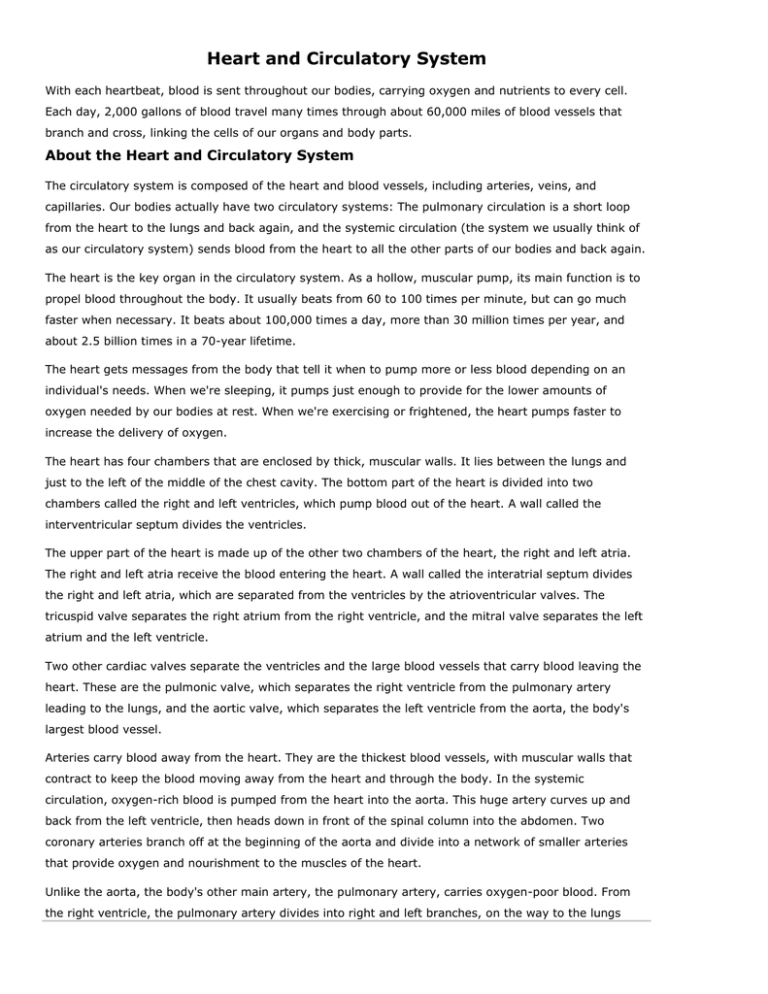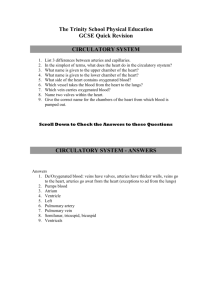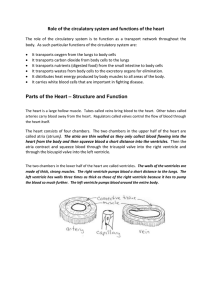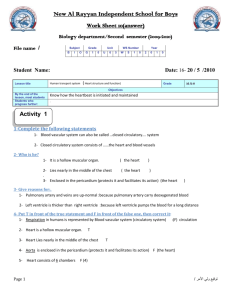
Heart and Circulatory System
With each heartbeat, blood is sent throughout our bodies, carrying oxygen and nutrients to every cell.
Each day, 2,000 gallons of blood travel many times through about 60,000 miles of blood vessels that
branch and cross, linking the cells of our organs and body parts.
About the Heart and Circulatory System
The circulatory system is composed of the heart and blood vessels, including arteries, veins, and
capillaries. Our bodies actually have two circulatory systems: The pulmonary circulation is a short loop
from the heart to the lungs and back again, and the systemic circulation (the system we usually think of
as our circulatory system) sends blood from the heart to all the other parts of our bodies and back again.
The heart is the key organ in the circulatory system. As a hollow, muscular pump, its main function is to
propel blood throughout the body. It usually beats from 60 to 100 times per minute, but can go much
faster when necessary. It beats about 100,000 times a day, more than 30 million times per year, and
about 2.5 billion times in a 70-year lifetime.
The heart gets messages from the body that tell it when to pump more or less blood depending on an
individual's needs. When we're sleeping, it pumps just enough to provide for the lower amounts of
oxygen needed by our bodies at rest. When we're exercising or frightened, the heart pumps faster to
increase the delivery of oxygen.
The heart has four chambers that are enclosed by thick, muscular walls. It lies between the lungs and
just to the left of the middle of the chest cavity. The bottom part of the heart is divided into two
chambers called the right and left ventricles, which pump blood out of the heart. A wall called the
interventricular septum divides the ventricles.
The upper part of the heart is made up of the other two chambers of the heart, the right and left atria.
The right and left atria receive the blood entering the heart. A wall called the interatrial septum divides
the right and left atria, which are separated from the ventricles by the atrioventricular valves. The
tricuspid valve separates the right atrium from the right ventricle, and the mitral valve separates the left
atrium and the left ventricle.
Two other cardiac valves separate the ventricles and the large blood vessels that carry blood leaving the
heart. These are the pulmonic valve, which separates the right ventricle from the pulmonary artery
leading to the lungs, and the aortic valve, which separates the left ventricle from the aorta, the body's
largest blood vessel.
Arteries carry blood away from the heart. They are the thickest blood vessels, with muscular walls that
contract to keep the blood moving away from the heart and through the body. In the systemic
circulation, oxygen-rich blood is pumped from the heart into the aorta. This huge artery curves up and
back from the left ventricle, then heads down in front of the spinal column into the abdomen. Two
coronary arteries branch off at the beginning of the aorta and divide into a network of smaller arteries
that provide oxygen and nourishment to the muscles of the heart.
Unlike the aorta, the body's other main artery, the pulmonary artery, carries oxygen-poor blood. From
the right ventricle, the pulmonary artery divides into right and left branches, on the way to the lungs
where blood picks up oxygen.
Arterial walls have three layers:
1. The endothelium is on the inside and provides a smooth lining for blood to flow over as it
moves through the artery.
2. The media is the middle part of the artery, made up of a layer of muscle and elastic tissue.
3. The adventitia is the tough covering that protects the outside of the artery.
As they get farther from the heart, the arteries branch out into arterioles, which are smaller and less
elastic.
Veins carry blood back to the heart. They're not as muscular as arteries, but they contain valves that
prevent blood from flowing backward. Veins have the same three layers that arteries do, but are thinner
and less flexible. The two largest veins are the superior and inferior vena cavae. The terms superior and
inferior don't mean that one vein is better than the other, but that they're located above and below the
heart.
A network of tiny capillaries connects the arteries and veins. Though tiny, the capillaries are one of the
most important parts of the circulatory system because it's through them that nutrients and oxygen are
delivered to the cells. In addition, waste products such as carbon dioxide are also removed by the
capillaries.
What the Heart and Circulatory System Do
The circulatory system works closely with other systems in our bodies. It supplies oxygen and nutrients
to our bodies by working with the respiratory system. At the same time, the circulatory system helps
carry waste and carbon dioxide out of the body.
Hormones — produced by the endocrine system — are also transported through the blood in the
circulatory system. As the body's chemical messengers, hormones transfer information and instructions
from one set of cells to another. For example, one of the hormones produced by the heart helps control
the kidneys' release of salt from the body.
One complete heartbeat makes up a cardiac cycle, which consists of two phases:
1. In the first phase, the ventricles contract (this is called systole), sending blood into the
pulmonary and systemic circulation. To prevent the flow of blood backwards into the atria during
systole, the atrioventricular valves close, creating the first sound (the lub). When the ventricles
finish contracting, the aortic and pulmonary valves close to prevent blood from flowing back into
the ventricles. This is what creates the second sound (the dub).
2. Then the ventricles relax (this is called diastole) and fill with blood from the atria, which makes
up the second phase of the cardiac cycle.
A unique electrical conduction system in the heart causes it to beat in its regular rhythm. The sinoatrial
or SA node, a small area of tissue in the wall of the right atrium, sends out an electrical signal to start
the contracting of the heart muscle. This node is called the pacemaker of the heart because it sets the
rate of the heartbeat and causes the rest of the heart to contract in its rhythm.
These electrical impulses cause the atria to contract first, and then travel down to the atrioventricular or
AV node, which acts as a kind of relay station. From here the electrical signal travels through the right
and left ventricles, causing them to contract and forcing blood out into the major arteries.
In the systemic circulation, blood travels out of the left ventricle, to the aorta, to every organ and tissue
in the body, and then back to the right atrium. The arteries, capillaries, and veins of the systemic
circulatory system are the channels through which this long journey takes place.
Once in the arteries, blood flows to smaller arterioles and then to capillaries. While in the capillaries, the
bloodstream delivers oxygen and nutrients to the body's cells and picks up waste materials. Blood then
goes back through the capillaries into venules, and then to larger veins until it reaches the vena cavae.
Blood from the head and arms returns to the heart through the superior vena cava, and blood from the
lower parts of the body returns through the inferior vena cava. Both vena cavae deliver this oxygendepleted blood into the right atrium. From here the blood exits to fill the right ventricle, ready to be
pumped into the pulmonary circulation for more oxygen.
In the pulmonary circulation, blood low in oxygen but high in carbon dioxide is pumped out the right
ventricle into the pulmonary artery, which branches off in two directions. The right branch goes to the
right lung, and vice versa.
In the lungs, the branches divide further into capillaries. Blood flows more slowly through these tiny
vessels, allowing time for gases to be exchanged between the capillary walls and the millions of alveoli,
the tiny air sacs in the lungs.
During the process called oxygenation, oxygen is taken up by the bloodstream. Oxygen locks onto a
molecule called hemoglobin in the red blood cells. The newly oxygenated blood leaves the lungs through
the pulmonary veins and heads back to the heart. It enters the heart in the left atrium, then fills the left
ventricle so it can be pumped into the systemic circulation.
Problems of the Heart and Circulatory System
Problems with the cardiovascular system are common — more than 64 million Americans have some type
of cardiac problem. But cardiovascular problems don't just affect older people — many heart and
circulatory system problems affect children and teens, too.
Heart and circulatory problems are grouped into two categories: congenital (problems present at birth)
and acquired (problems developed some time after birth).
Congenital heart defects. These abnormalities in the heart's structure are present at birth.
Approximately 8 out of every 1,000 newborns have congenital heart defects ranging from mild to severe.
These defects occur while the fetus is developing in the mother's uterus and it's not usually known why
they occur. Some congenital heart defects are caused by genetic disorders, but most are not. What all
congenital heart defects have in common, however, is that they involve abnormal or incomplete
development of the heart.
A common sign of a congenital heart defect is a heart murmur — an abnormal sound (like a blowing or
whooshing sound) that's heard when listening to the heart. Usually a heart murmur is detected by a
doctor who's listening to the heart with a stethoscope during a routine exam. Murmurs are very common
in children and can be “innocent murmurs” found in an otherwise healthy heart. Other murmurs can be
caused by congenital heart defects or other heart conditions.
Arrhythmia. Cardiac arrhythmias, also called dysrhythmias or rhythm disorders, are problems in the
rhythm of the heartbeat. They may be caused by a congenital heart defect or they may be acquired later.
An arrhythmia may cause the heart's rhythm to be irregular, abnormally fast, or abnormally slow.
Arrhythmias can occur at any age and may be discovered during a routine physical examination.
Depending on the type of rhythm disorder, an arrhythmia may be treated with medication, surgery, or
pacemakers. Some arrhythmias are not harmful.
Cardiomyopathy. This chronic disease causes the heart muscle (the myocardium) to become
weakened. Usually, it first affects the lower chambers of the heart, the ventricles, and then progresses
and damages the muscle cells and even the tissues surrounding the heart. In its most severe forms, it
can lead to heart failure and even death. Cardiomyopathy is the #1 reason for heart transplants in
children.
Coronary artery disease. The most common heart disorder in adults, coronary artery disease is caused
by atherosclerosis. Deposits of fat, calcium, and dead cells, called atherosclerotic plaques, form on the
inner walls of the coronary arteries (the blood vessels that supply the heart) and interfere with the
smooth flow of blood. Blood flow to the heart muscle may even stop if a thrombus, or clot, forms in a
coronary vessel, which may cause a heart attack. In a heart attack (or myocardial infarction), the heart
muscle becomes damaged by lack of oxygen, and unless blood flow returns within minutes, muscle
damage increases and the heart's ability to pump blood is compromised. If the clot can be dissolved
within a few hours, damage to the heart can be reduced. Heart attacks are rare in kids and teens.
Hypercholesterolemia (high cholesterol). Cholesterol is a waxy substance that's found in the body's
cells, in the blood, and in some foods. Having too much cholesterol in the blood, also known as
hypercholesterolemia, is a major risk factor for heart disease and can lead to a heart attack.
Cholesterol is carried in the bloodstream by lipoproteins. Two kinds — low-density lipoproteins (LDL) and
high-density lipoproteins (HDL) — are the most important. High levels of LDL cholesterol (the bad
cholesterol) increase a person's risk for heart disease and stroke, whereas high levels of HDL cholesterol
(the good cholesterol) can protect against these.
A blood test can measure if someone's cholesterol is too high. A child's total cholesterol level is
borderline if it's 170 to 199 mg/dL, and it's considered high if it's above 200 mg/dL.
About 10% of teens between 12 and 19 have high cholesterol levels that put them at increased risk of
cardiovascular disease.
High blood pressure (hypertension). Over time, high blood pressure can damage the heart, arteries,
and other body organs. Symptoms can include headache, nosebleeds, dizziness, and lightheadedness.
Infants, kids, and teens can have high blood pressure, which may be caused by genetic factors, excess
body weight, diet, lack of exercise, and diseases such as heart disease or kidney disease.
Kawasaki disease. Also known as mucocutaneous lymph node syndrome, Kawasaki disease affects the
mucous membranes (the lining of the mouth and breathing passages), the skin, and the lymph nodes
(part of the immune system). It can also lead to vasculitis, an inflammation of the blood vessels. This
can affect all major arteries in the body — including the coronary arteries. When coronary arteries
become inflamed, a child can develop aneurysms, which are weakened and bulging spots on the walls of
arteries. This increases the risk of a blood clot forming in this weakened area, which can block the artery,
possibly leading to a heart attack. In addition to the coronary arteries, the heart muscle, lining, valves,
or the outer membrane that surrounds the heart can become inflamed. Arrhythmias or abnormal
functioning of some heart valves can occur. Kawasaki disease has surpassed rheumatic fever as the
leading cause of acquired heart disease in children in the United States.
Rheumatic heart disease. Usually the complication of an untreated strep throat infection, rheumatic
fever can lead to permanent heart damage and even death. Most common in kids between 5 and 15
years of age, it begins when antibodies the body produces to fight the strep infection begin to attack
other parts of the body. They react to tissues in the heart valves as though they were the strep bacteria
and cause the heart valves to thicken and scar. Inflammation and weakening of the heart muscle may
also occur. Usually, when strep throat infections are promptly treated with antibiotics, this condition can
be avoided.
Stroke. Strokes occur when the blood supply to the brain is cut off or when a blood vessel in the brain
bursts and spills blood into an area of the brain, causing damage to brain cells. Children or infants who
have experienced stroke may be suddenly numb or weak, especially on one side of the body, and they
may experience a sudden severe headache, nausea or vomiting, and difficulty seeing, speaking, walking,
or moving. During childhood, strokes are rare.
Getting plenty of exercise, eating a nutritious diet, maintaining a healthy weight, and getting regular
medical checkups are the best ways to help keep the heart healthy and avoid long-term problems like
high blood pressure, high cholesterol, and heart disease.
Reviewed by: Yamini Durani, MD
Date reviewed: January 2013
Note: All information on KidsHealth® is for educational purposes only. For specific medical advice,
diagnoses, and treatment, consult your doctor.
© 1995- 2014 The Nemours Foundation. All rights reserved.








